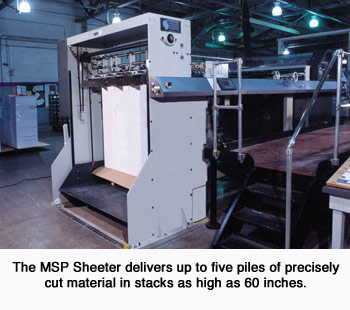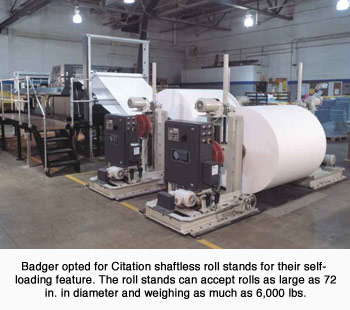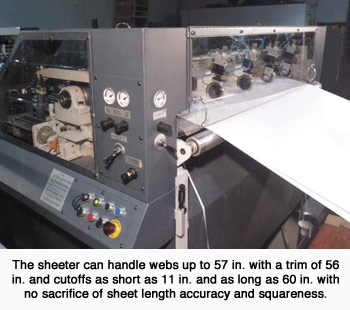After re-evaluating economic conditions, Badger Paper Mills, Inc. in Peshtigo, WI recognized that converting is a value-added element in the specialty market that must continually be expanded. Badger’s strategic plan is composed of a corporate reinvention that includes a close look at product mix, equipment, and market as well as forging a relationship with Maxson Automatic Machinery Company.
What are some of the key points to this strategic plan? Mark Neumann, Vice President of Sales, stated these points are evaluating economic conditions, Badger’s position in the marketplace, and potential areas of growth. “We produced excellent fine white paper products with recognizable names such as Copyright, and Ta-Non-Ka,” Neumann reported. “We asked ourselves, did we want to attempt to increase our market share by making more and more of a product that had already matured, or was our growth going to be realized by expanding into other areas.” A strategic plan was developed to replace commodity papers with specialty papers. “In 1996, we stated we wanted our specialty products to make up 55% of our annual sales by the year 2000. We nearly hit that number in 1998 when our specialty sales hit 53%. This was an increase of 16% over 1997, when specialty sales accounted for just 37% of total sales,” explained Neumann. “We continue to grow in specialty products and have carved out a specialized niche that satisfies quick response to smaller orders.”

Badger also embarked on ISO 9001 certification in 1996, which supports the quality and consistency needed to meet the demands of their customers. The entire organization supports ISO because of the value it brings. Badger has been the recipient of commendations from auditors several times.
To improve the manufacturing infrastructure at Badger, many capital improvements have been implemented according to Chief Operating Officer, Michael Bekes. “Badger Paper justified machinery upgrades in a number of areas,” Bekes stated. “There have been a number of modifications and improvements on both our Fourdrinier and Yankee paper machines over last three years. We have added state of the art computer control systems on both paper machines; a web inspection system; new digital drives; and improved chemical addition systems. These capital improvements have increased capacity and are producing a consistently better product.”
It would be amazing to get through a day without using one of a plethora of Badger Paper products – the sterilized wrap on a Band-Aid, a piece of ink jet paper, or the glassine type bag that houses new guitar string. Many products produced by Badger use a waxing process. With Dry Waxed Papers, the wax is applied to one or both sides of the sheet. Butter wrap, gum wrap, and those little ‘soufflé’ cups, which are used for ketchup at restaurants, are processed this way. Wet Wax Papers have a continuous wax film on one or both surfaces. Taffy wrap, bread wrap, and cough drop are examples of these types of paper. Michael Bekes explained, “Specialty products are often colorful products. Now, in addition to our 28 stocking shades, Badger also produces over 250 different colors to help customers match a need, our on-line Color Control System guarantee consistent color from run to run.”

Adding to the grade mix are new folio sized paper products and a need to expand the finishing department to handle this increased volume. Badger took a close look at mill-wide production streams and realized that the converting department had an obstacle concerning antiquated sheeting equipment. Production speeds were limited by the age and wear of the equipment and quality was somewhat inconsistent. Their decision to upgrade the part of their converting brought them to Maxson Automatic Machinery Company.
“We certainly did our homework concerning sheeting equipment evaluation,” asserts Mark Bruemmer, Finishing/Shipping Supervisor. “We projected numbers, calculated an excellent ROI and justified the purchase of a Maxson Automatic Machinery Company MSP Sheeter. This machine will pay for itself in a relatively short time. This new sheeter has also almost totally eliminated the need to out source converting of folio sizes. This gives us total control of our inventory, production schedule and saves money. Installation of this equipment has increased throughput of our folio sheeting by 250% and has smoothed out a significant production problem,” Bruemmer continued.
The Maxson MSP Sheeter is equipped with two Citation, self-loading roll stands. Rolls as large as 72 inches (1830 mm) in diameter weighing as much as 6,000 lbs. (2725 kg) can simply be pushed into place between two posts and raised into position. The Citation is designed to decrease roll changeover time and increase productivity. There are no overhead hoists and no risk of injury. “We have realized that additional roll stands will increase our productivity proportionately,” added Bruemmer.

“We are getting more familiar with the machine all the time and are running a wide range of basis weights from 20 lb. to 80 lb. (30 gsm to 120 gsm) on an assortment of paper grades. These include machine finished grades, WOGR papers (water, oil and grease resistant) and MICR (Magnetic Ink Character Recognition) as well as a virgin and recycled printing papers,” reported Bruemmer. “Because of the ease of material changeover and quick set up, we can respond to short runs and will accept a special size order in small quantities. We’ve had excellent training by Maxson technicians and we feel free to call for advice whenever we need it.”
The Maxson MSP Sheeter can handle webs up to 57 inches (1447 mm) and cutoffs as short as 11 inches (254 mm) and as long as 60 inches (1525 mm) with no sacrifice to the sheet length accuracy of ±0.015 inches (+ 0.38 mm). Cut off accuracy is maintained by a microprocessor controlled dual motor drive system. Using high resolution encoders to feed back to the microprocessor, which governs the two AC drive system, the knife revolver motor follows the proportional speed of the draw drum motor AC motor precisely. Since there are no adjustable mechanical components, length variation due to wear is eliminated. There is no need whatsoever to guillotine trim folio sizes.
Further, because the cutter is equipped with six, air loaded top slitters; the MSP can also deliver up to five piles of precisely cut material in smaller A4 sheet format. In the MSP’s delivery system, Maxson’s patented Airfoil Overlap System provides an improved method of overlapping sheets at high speed. This system provides jam-free performance, particularly when single web runs are necessary on lightweight grades.
“We’re convinced that we made the right decision by installing the Maxson MSP Sheeter. Badger realizes that converting is a value-added element and must be continually expanded,” summarized Bruemmer.
Reprinted from Pulp & Paper, October 2001






